BP plc: IFRS, Conceptual Framework, and Disclosure Report
VerifiedAdded on 2022/08/22
|11
|3115
|32
Report
AI Summary
This report, prepared for the board of directors of BP plc, examines key aspects of international financial reporting. It begins by discussing the necessity of an agreed-upon international conceptual framework for financial reporting, highlighting its role in resolving accounting issues and providing a basis for standard-setting by the IASB and FASB. The report then delves into the topic of disclosure, evaluating the need for an optimal level of information in annual reports and addressing the potential for excessive disclosure to be burdensome or ineffective for users. Furthermore, the report analyzes the weaknesses inherent in older revenue recognition standards (IAS 18 and IAS 11) and how IFRS 15 aims to rectify these deficiencies, providing a more robust and consistent approach to revenue recognition. The report underscores the significance of these elements for effective financial reporting and informed decision-making within the company.
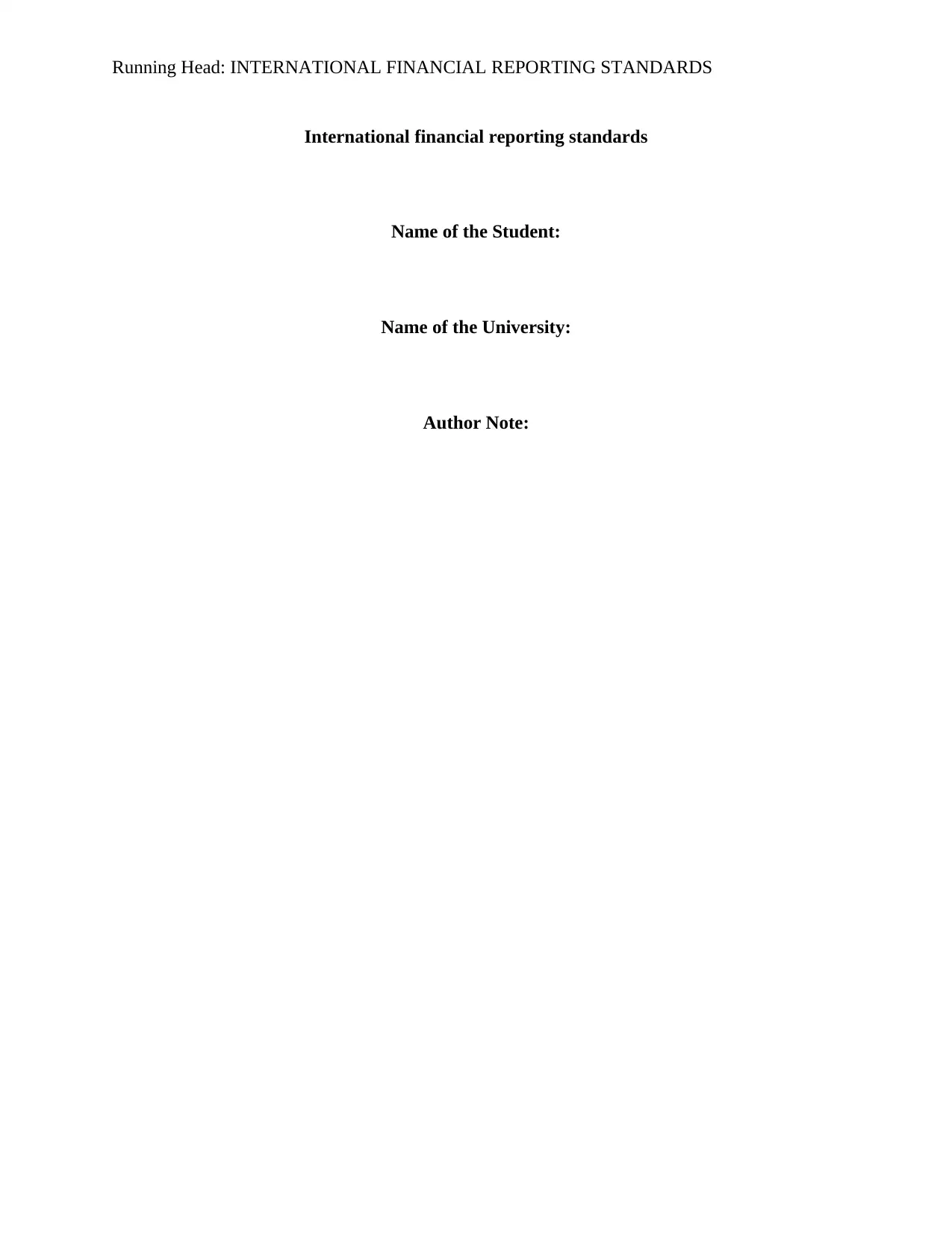
Running Head: INTERNATIONAL FINANCIAL REPORTING STANDARDS
International financial reporting standards
Name of the Student:
Name of the University:
Author Note:
International financial reporting standards
Name of the Student:
Name of the University:
Author Note:
Paraphrase This Document
Need a fresh take? Get an instant paraphrase of this document with our AI Paraphraser
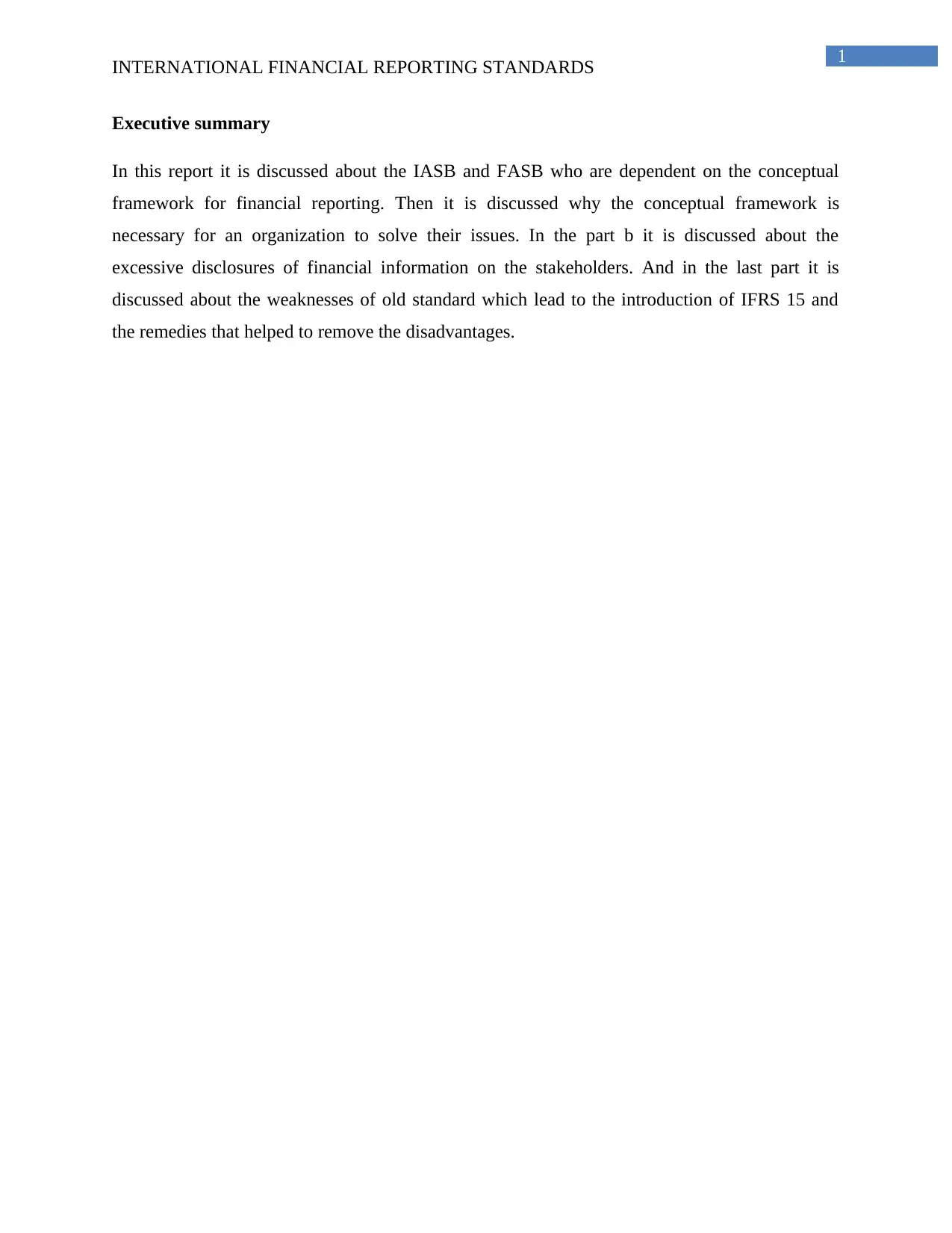
1
INTERNATIONAL FINANCIAL REPORTING STANDARDS
Executive summary
In this report it is discussed about the IASB and FASB who are dependent on the conceptual
framework for financial reporting. Then it is discussed why the conceptual framework is
necessary for an organization to solve their issues. In the part b it is discussed about the
excessive disclosures of financial information on the stakeholders. And in the last part it is
discussed about the weaknesses of old standard which lead to the introduction of IFRS 15 and
the remedies that helped to remove the disadvantages.
INTERNATIONAL FINANCIAL REPORTING STANDARDS
Executive summary
In this report it is discussed about the IASB and FASB who are dependent on the conceptual
framework for financial reporting. Then it is discussed why the conceptual framework is
necessary for an organization to solve their issues. In the part b it is discussed about the
excessive disclosures of financial information on the stakeholders. And in the last part it is
discussed about the weaknesses of old standard which lead to the introduction of IFRS 15 and
the remedies that helped to remove the disadvantages.
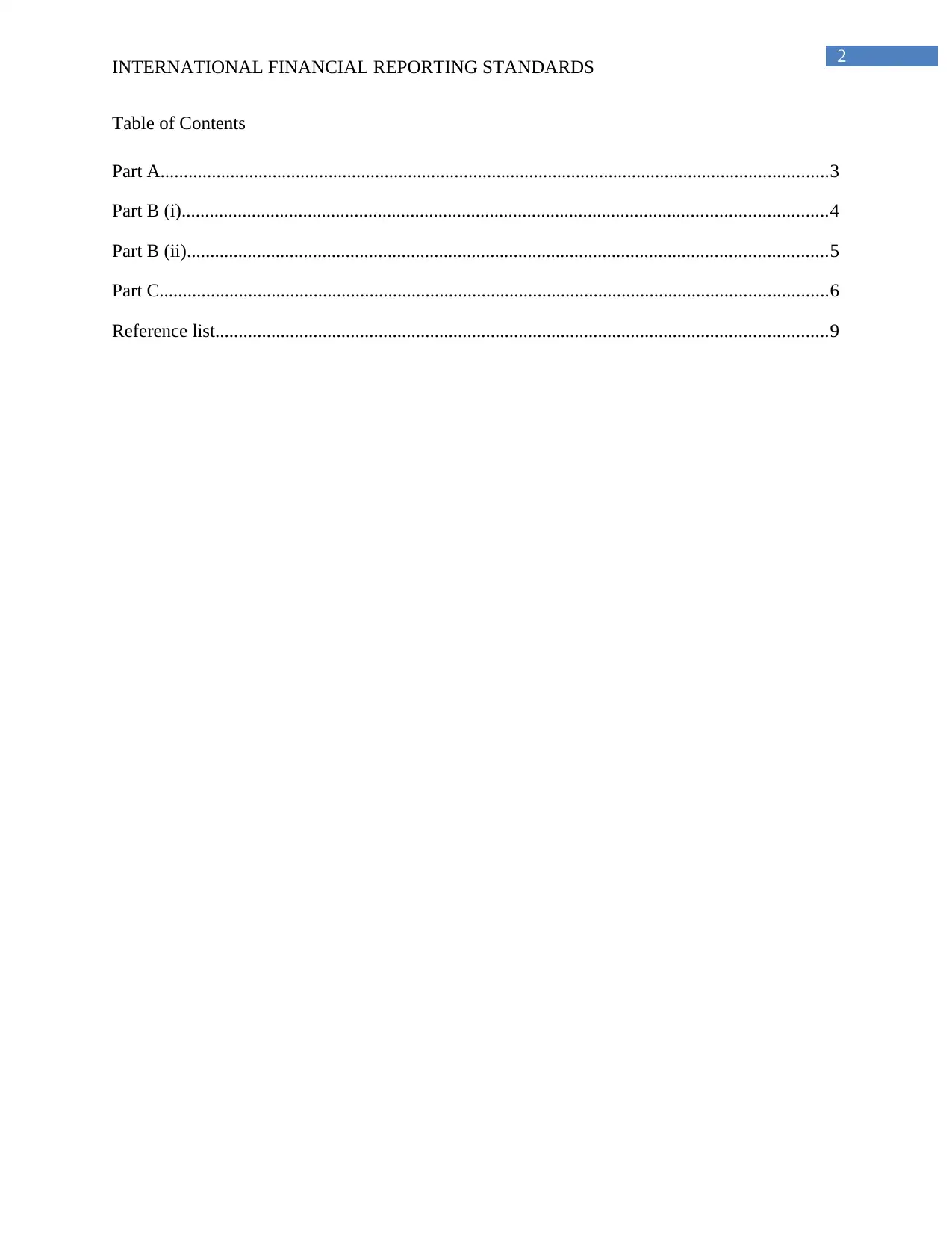
2
INTERNATIONAL FINANCIAL REPORTING STANDARDS
Table of Contents
Part A...............................................................................................................................................3
Part B (i)..........................................................................................................................................4
Part B (ii).........................................................................................................................................5
Part C...............................................................................................................................................6
Reference list...................................................................................................................................9
INTERNATIONAL FINANCIAL REPORTING STANDARDS
Table of Contents
Part A...............................................................................................................................................3
Part B (i)..........................................................................................................................................4
Part B (ii).........................................................................................................................................5
Part C...............................................................................................................................................6
Reference list...................................................................................................................................9
⊘ This is a preview!⊘
Do you want full access?
Subscribe today to unlock all pages.

Trusted by 1+ million students worldwide

3
INTERNATIONAL FINANCIAL REPORTING STANDARDS
Part A
An international conceptual framework for a financial reporting is the main foundation
upon which an International Accounting Standard Board (IASB) develops new accounting
standards. It is an idea of creating a system consisting of ideas and objectives which lead to the
creation or setting of Standards. Its main objective is to identify the goals and purpose of the
financial reporting while providing the fundamentals that help in achieving those objectives.
Conceptual framework is mainly served as the tool for the IASB to assist the IFRS for
interpretation and developing accounting standards. All the requirements are fulfilled by the
IFRS are set the frameworks (Kober, Lee and Ng 2020). Some companies use this Framework
for using it as a reference in selecting the accounting policies they need to adopt in their system.
Conceptual framework releases the changes or revises the existing framework for giving
direction for the IFRS in the future. Framework is revised to provide all set of important tools to
the companies or organization for setting standards according to their needs.
The direct benefit of the conceptual framework is the FASB as it provides the foundation
for setting the standard and tools for solving accounting issues. The Financial Accounting
Standard Board’s (FASB) framework helps an organization by setting the financial accounting
standards to help the user of it not only to understand or apply but also to use it for the
development of the organization. It helps to solve many complex financial accounting issues like
forming a basis for discussion, providing the terminology, help to raise right question, limiting
the area of judgment, providing potential solution and applying an intellectual discipline.
Financial reporting is enhanced when the objective and concept to provide structure and
direction is clear. So the user of the financial statement gets the benefit of the framework issued
by the FASB (Baker 2017).
Financial information is mainly used by the investors, lenders and creditors for making
decisions about the organization financial condition. International frameworks helps to set the
information that are needed to be assessed by the management so that the users can assess the
prospect of the organization future cash flows (Linsmeier 2016). Frameworks consist of
qualitative characteristics that are useful for the financial information and are subject to the cost
constrains. So it is important for an organization to determine the benefit that they are going to
INTERNATIONAL FINANCIAL REPORTING STANDARDS
Part A
An international conceptual framework for a financial reporting is the main foundation
upon which an International Accounting Standard Board (IASB) develops new accounting
standards. It is an idea of creating a system consisting of ideas and objectives which lead to the
creation or setting of Standards. Its main objective is to identify the goals and purpose of the
financial reporting while providing the fundamentals that help in achieving those objectives.
Conceptual framework is mainly served as the tool for the IASB to assist the IFRS for
interpretation and developing accounting standards. All the requirements are fulfilled by the
IFRS are set the frameworks (Kober, Lee and Ng 2020). Some companies use this Framework
for using it as a reference in selecting the accounting policies they need to adopt in their system.
Conceptual framework releases the changes or revises the existing framework for giving
direction for the IFRS in the future. Framework is revised to provide all set of important tools to
the companies or organization for setting standards according to their needs.
The direct benefit of the conceptual framework is the FASB as it provides the foundation
for setting the standard and tools for solving accounting issues. The Financial Accounting
Standard Board’s (FASB) framework helps an organization by setting the financial accounting
standards to help the user of it not only to understand or apply but also to use it for the
development of the organization. It helps to solve many complex financial accounting issues like
forming a basis for discussion, providing the terminology, help to raise right question, limiting
the area of judgment, providing potential solution and applying an intellectual discipline.
Financial reporting is enhanced when the objective and concept to provide structure and
direction is clear. So the user of the financial statement gets the benefit of the framework issued
by the FASB (Baker 2017).
Financial information is mainly used by the investors, lenders and creditors for making
decisions about the organization financial condition. International frameworks helps to set the
information that are needed to be assessed by the management so that the users can assess the
prospect of the organization future cash flows (Linsmeier 2016). Frameworks consist of
qualitative characteristics that are useful for the financial information and are subject to the cost
constrains. So it is important for an organization to determine the benefit that they are going to
Paraphrase This Document
Need a fresh take? Get an instant paraphrase of this document with our AI Paraphraser
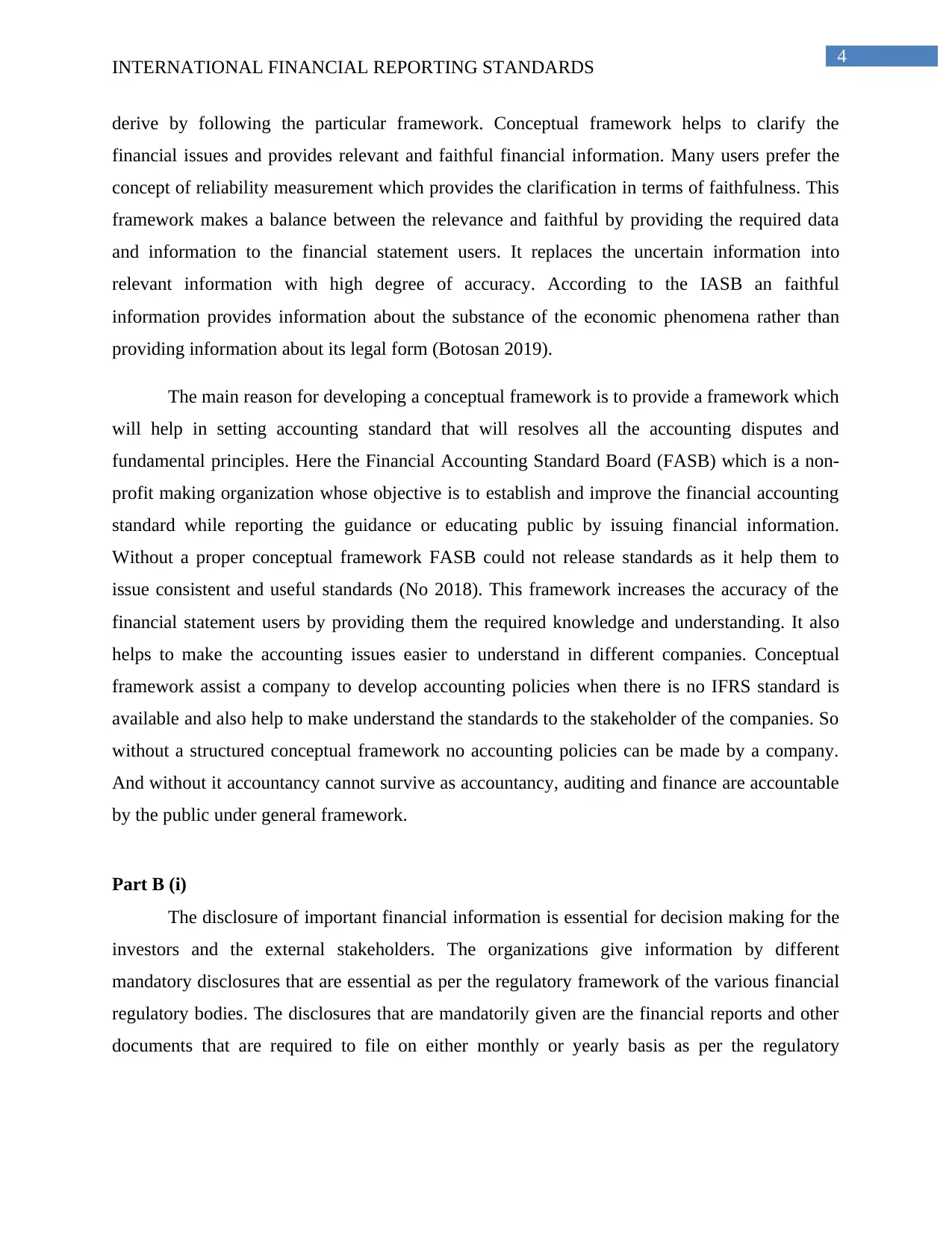
4
INTERNATIONAL FINANCIAL REPORTING STANDARDS
derive by following the particular framework. Conceptual framework helps to clarify the
financial issues and provides relevant and faithful financial information. Many users prefer the
concept of reliability measurement which provides the clarification in terms of faithfulness. This
framework makes a balance between the relevance and faithful by providing the required data
and information to the financial statement users. It replaces the uncertain information into
relevant information with high degree of accuracy. According to the IASB an faithful
information provides information about the substance of the economic phenomena rather than
providing information about its legal form (Botosan 2019).
The main reason for developing a conceptual framework is to provide a framework which
will help in setting accounting standard that will resolves all the accounting disputes and
fundamental principles. Here the Financial Accounting Standard Board (FASB) which is a non-
profit making organization whose objective is to establish and improve the financial accounting
standard while reporting the guidance or educating public by issuing financial information.
Without a proper conceptual framework FASB could not release standards as it help them to
issue consistent and useful standards (No 2018). This framework increases the accuracy of the
financial statement users by providing them the required knowledge and understanding. It also
helps to make the accounting issues easier to understand in different companies. Conceptual
framework assist a company to develop accounting policies when there is no IFRS standard is
available and also help to make understand the standards to the stakeholder of the companies. So
without a structured conceptual framework no accounting policies can be made by a company.
And without it accountancy cannot survive as accountancy, auditing and finance are accountable
by the public under general framework.
Part B (i)
The disclosure of important financial information is essential for decision making for the
investors and the external stakeholders. The organizations give information by different
mandatory disclosures that are essential as per the regulatory framework of the various financial
regulatory bodies. The disclosures that are mandatorily given are the financial reports and other
documents that are required to file on either monthly or yearly basis as per the regulatory
INTERNATIONAL FINANCIAL REPORTING STANDARDS
derive by following the particular framework. Conceptual framework helps to clarify the
financial issues and provides relevant and faithful financial information. Many users prefer the
concept of reliability measurement which provides the clarification in terms of faithfulness. This
framework makes a balance between the relevance and faithful by providing the required data
and information to the financial statement users. It replaces the uncertain information into
relevant information with high degree of accuracy. According to the IASB an faithful
information provides information about the substance of the economic phenomena rather than
providing information about its legal form (Botosan 2019).
The main reason for developing a conceptual framework is to provide a framework which
will help in setting accounting standard that will resolves all the accounting disputes and
fundamental principles. Here the Financial Accounting Standard Board (FASB) which is a non-
profit making organization whose objective is to establish and improve the financial accounting
standard while reporting the guidance or educating public by issuing financial information.
Without a proper conceptual framework FASB could not release standards as it help them to
issue consistent and useful standards (No 2018). This framework increases the accuracy of the
financial statement users by providing them the required knowledge and understanding. It also
helps to make the accounting issues easier to understand in different companies. Conceptual
framework assist a company to develop accounting policies when there is no IFRS standard is
available and also help to make understand the standards to the stakeholder of the companies. So
without a structured conceptual framework no accounting policies can be made by a company.
And without it accountancy cannot survive as accountancy, auditing and finance are accountable
by the public under general framework.
Part B (i)
The disclosure of important financial information is essential for decision making for the
investors and the external stakeholders. The organizations give information by different
mandatory disclosures that are essential as per the regulatory framework of the various financial
regulatory bodies. The disclosures that are mandatorily given are the financial reports and other
documents that are required to file on either monthly or yearly basis as per the regulatory
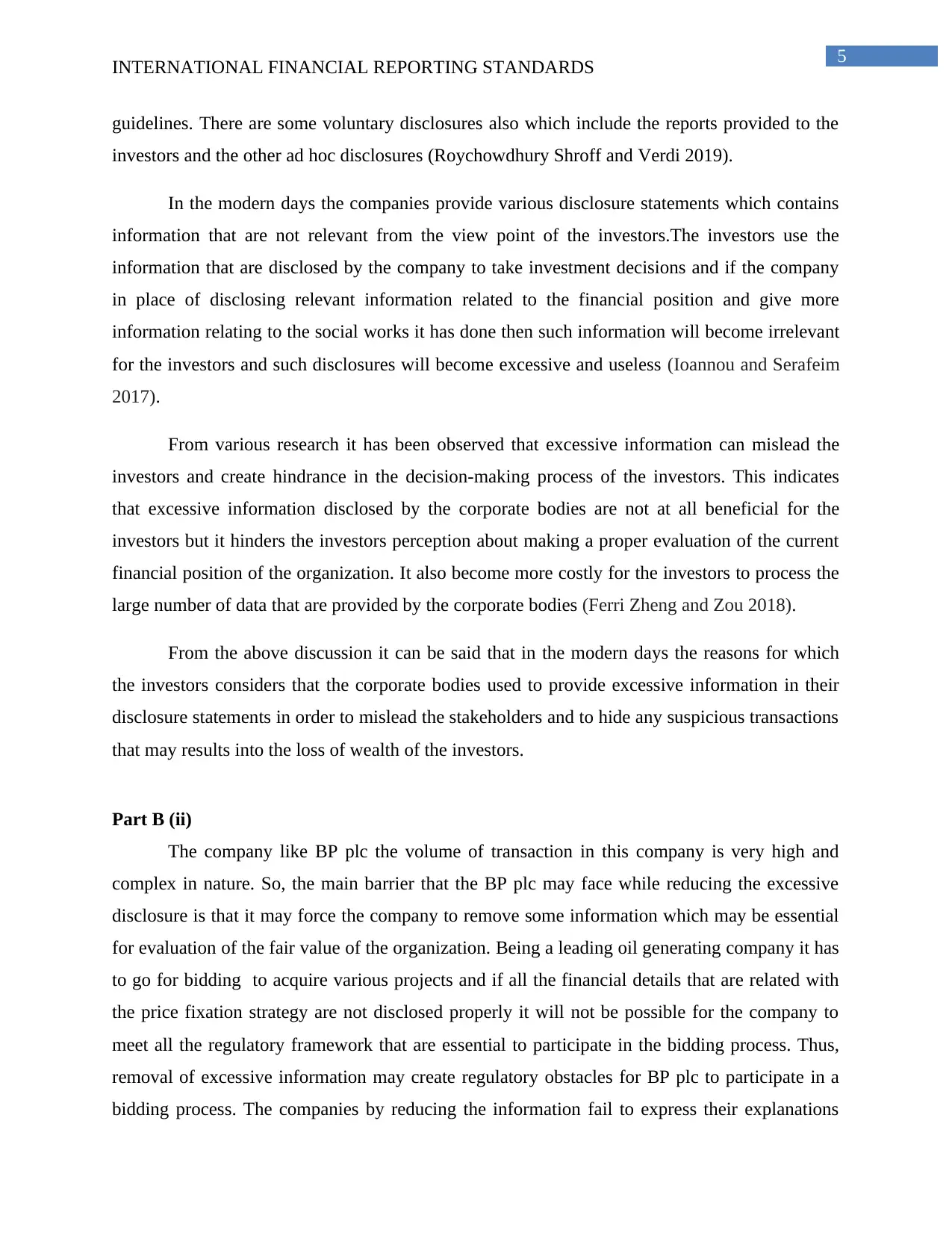
5
INTERNATIONAL FINANCIAL REPORTING STANDARDS
guidelines. There are some voluntary disclosures also which include the reports provided to the
investors and the other ad hoc disclosures (Roychowdhury Shroff and Verdi 2019).
In the modern days the companies provide various disclosure statements which contains
information that are not relevant from the view point of the investors.The investors use the
information that are disclosed by the company to take investment decisions and if the company
in place of disclosing relevant information related to the financial position and give more
information relating to the social works it has done then such information will become irrelevant
for the investors and such disclosures will become excessive and useless (Ioannou and Serafeim
2017).
From various research it has been observed that excessive information can mislead the
investors and create hindrance in the decision-making process of the investors. This indicates
that excessive information disclosed by the corporate bodies are not at all beneficial for the
investors but it hinders the investors perception about making a proper evaluation of the current
financial position of the organization. It also become more costly for the investors to process the
large number of data that are provided by the corporate bodies (Ferri Zheng and Zou 2018).
From the above discussion it can be said that in the modern days the reasons for which
the investors considers that the corporate bodies used to provide excessive information in their
disclosure statements in order to mislead the stakeholders and to hide any suspicious transactions
that may results into the loss of wealth of the investors.
Part B (ii)
The company like BP plc the volume of transaction in this company is very high and
complex in nature. So, the main barrier that the BP plc may face while reducing the excessive
disclosure is that it may force the company to remove some information which may be essential
for evaluation of the fair value of the organization. Being a leading oil generating company it has
to go for bidding to acquire various projects and if all the financial details that are related with
the price fixation strategy are not disclosed properly it will not be possible for the company to
meet all the regulatory framework that are essential to participate in the bidding process. Thus,
removal of excessive information may create regulatory obstacles for BP plc to participate in a
bidding process. The companies by reducing the information fail to express their explanations
INTERNATIONAL FINANCIAL REPORTING STANDARDS
guidelines. There are some voluntary disclosures also which include the reports provided to the
investors and the other ad hoc disclosures (Roychowdhury Shroff and Verdi 2019).
In the modern days the companies provide various disclosure statements which contains
information that are not relevant from the view point of the investors.The investors use the
information that are disclosed by the company to take investment decisions and if the company
in place of disclosing relevant information related to the financial position and give more
information relating to the social works it has done then such information will become irrelevant
for the investors and such disclosures will become excessive and useless (Ioannou and Serafeim
2017).
From various research it has been observed that excessive information can mislead the
investors and create hindrance in the decision-making process of the investors. This indicates
that excessive information disclosed by the corporate bodies are not at all beneficial for the
investors but it hinders the investors perception about making a proper evaluation of the current
financial position of the organization. It also become more costly for the investors to process the
large number of data that are provided by the corporate bodies (Ferri Zheng and Zou 2018).
From the above discussion it can be said that in the modern days the reasons for which
the investors considers that the corporate bodies used to provide excessive information in their
disclosure statements in order to mislead the stakeholders and to hide any suspicious transactions
that may results into the loss of wealth of the investors.
Part B (ii)
The company like BP plc the volume of transaction in this company is very high and
complex in nature. So, the main barrier that the BP plc may face while reducing the excessive
disclosure is that it may force the company to remove some information which may be essential
for evaluation of the fair value of the organization. Being a leading oil generating company it has
to go for bidding to acquire various projects and if all the financial details that are related with
the price fixation strategy are not disclosed properly it will not be possible for the company to
meet all the regulatory framework that are essential to participate in the bidding process. Thus,
removal of excessive information may create regulatory obstacles for BP plc to participate in a
bidding process. The companies by reducing the information fail to express their explanations
⊘ This is a preview!⊘
Do you want full access?
Subscribe today to unlock all pages.

Trusted by 1+ million students worldwide
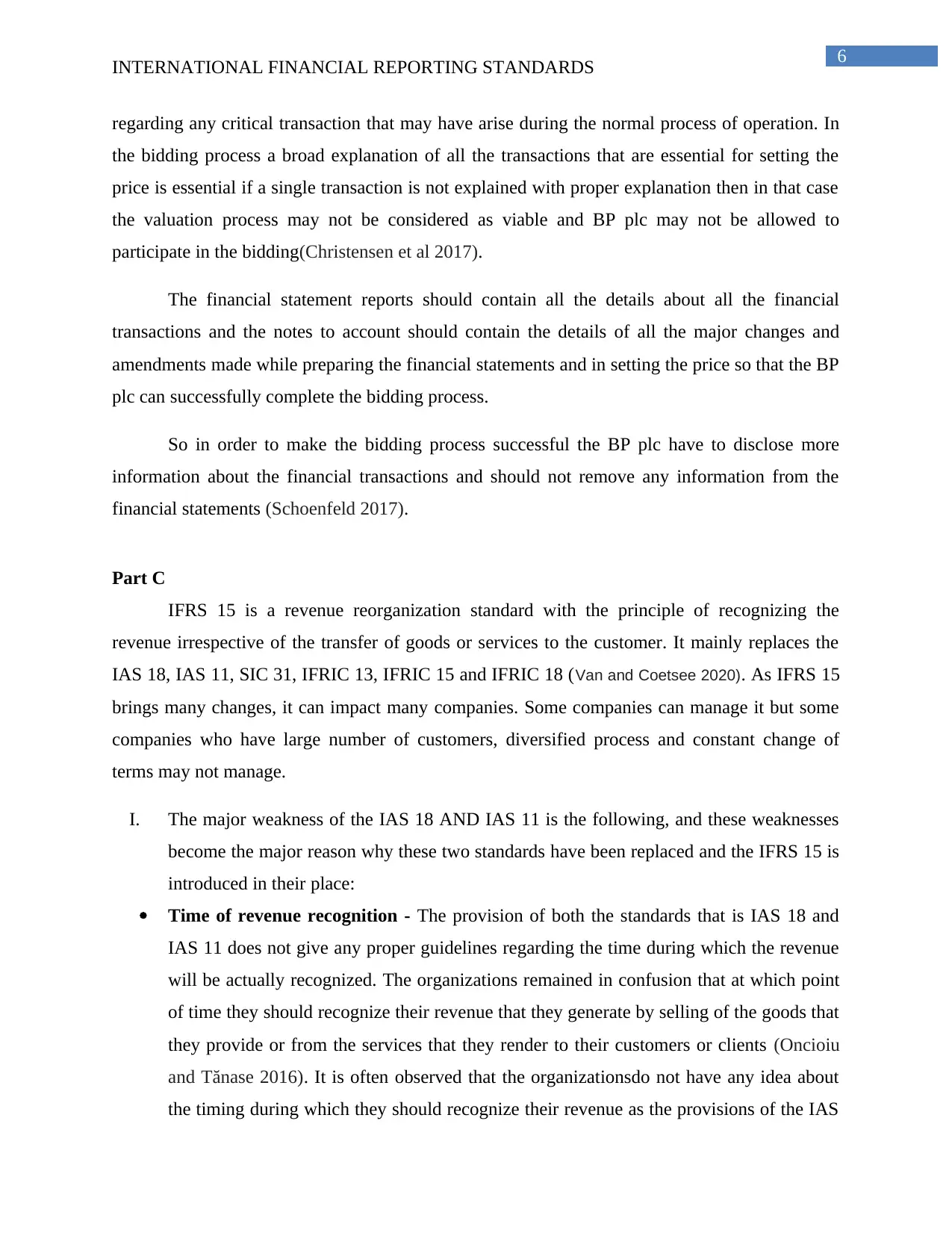
6
INTERNATIONAL FINANCIAL REPORTING STANDARDS
regarding any critical transaction that may have arise during the normal process of operation. In
the bidding process a broad explanation of all the transactions that are essential for setting the
price is essential if a single transaction is not explained with proper explanation then in that case
the valuation process may not be considered as viable and BP plc may not be allowed to
participate in the bidding(Christensen et al 2017).
The financial statement reports should contain all the details about all the financial
transactions and the notes to account should contain the details of all the major changes and
amendments made while preparing the financial statements and in setting the price so that the BP
plc can successfully complete the bidding process.
So in order to make the bidding process successful the BP plc have to disclose more
information about the financial transactions and should not remove any information from the
financial statements (Schoenfeld 2017).
Part C
IFRS 15 is a revenue reorganization standard with the principle of recognizing the
revenue irrespective of the transfer of goods or services to the customer. It mainly replaces the
IAS 18, IAS 11, SIC 31, IFRIC 13, IFRIC 15 and IFRIC 18 (Van and Coetsee 2020). As IFRS 15
brings many changes, it can impact many companies. Some companies can manage it but some
companies who have large number of customers, diversified process and constant change of
terms may not manage.
I. The major weakness of the IAS 18 AND IAS 11 is the following, and these weaknesses
become the major reason why these two standards have been replaced and the IFRS 15 is
introduced in their place:
Time of revenue recognition - The provision of both the standards that is IAS 18 and
IAS 11 does not give any proper guidelines regarding the time during which the revenue
will be actually recognized. The organizations remained in confusion that at which point
of time they should recognize their revenue that they generate by selling of the goods that
they provide or from the services that they render to their customers or clients (Oncioiu
and Tănase 2016). It is often observed that the organizationsdo not have any idea about
the timing during which they should recognize their revenue as the provisions of the IAS
INTERNATIONAL FINANCIAL REPORTING STANDARDS
regarding any critical transaction that may have arise during the normal process of operation. In
the bidding process a broad explanation of all the transactions that are essential for setting the
price is essential if a single transaction is not explained with proper explanation then in that case
the valuation process may not be considered as viable and BP plc may not be allowed to
participate in the bidding(Christensen et al 2017).
The financial statement reports should contain all the details about all the financial
transactions and the notes to account should contain the details of all the major changes and
amendments made while preparing the financial statements and in setting the price so that the BP
plc can successfully complete the bidding process.
So in order to make the bidding process successful the BP plc have to disclose more
information about the financial transactions and should not remove any information from the
financial statements (Schoenfeld 2017).
Part C
IFRS 15 is a revenue reorganization standard with the principle of recognizing the
revenue irrespective of the transfer of goods or services to the customer. It mainly replaces the
IAS 18, IAS 11, SIC 31, IFRIC 13, IFRIC 15 and IFRIC 18 (Van and Coetsee 2020). As IFRS 15
brings many changes, it can impact many companies. Some companies can manage it but some
companies who have large number of customers, diversified process and constant change of
terms may not manage.
I. The major weakness of the IAS 18 AND IAS 11 is the following, and these weaknesses
become the major reason why these two standards have been replaced and the IFRS 15 is
introduced in their place:
Time of revenue recognition - The provision of both the standards that is IAS 18 and
IAS 11 does not give any proper guidelines regarding the time during which the revenue
will be actually recognized. The organizations remained in confusion that at which point
of time they should recognize their revenue that they generate by selling of the goods that
they provide or from the services that they render to their customers or clients (Oncioiu
and Tănase 2016). It is often observed that the organizationsdo not have any idea about
the timing during which they should recognize their revenue as the provisions of the IAS
Paraphrase This Document
Need a fresh take? Get an instant paraphrase of this document with our AI Paraphraser
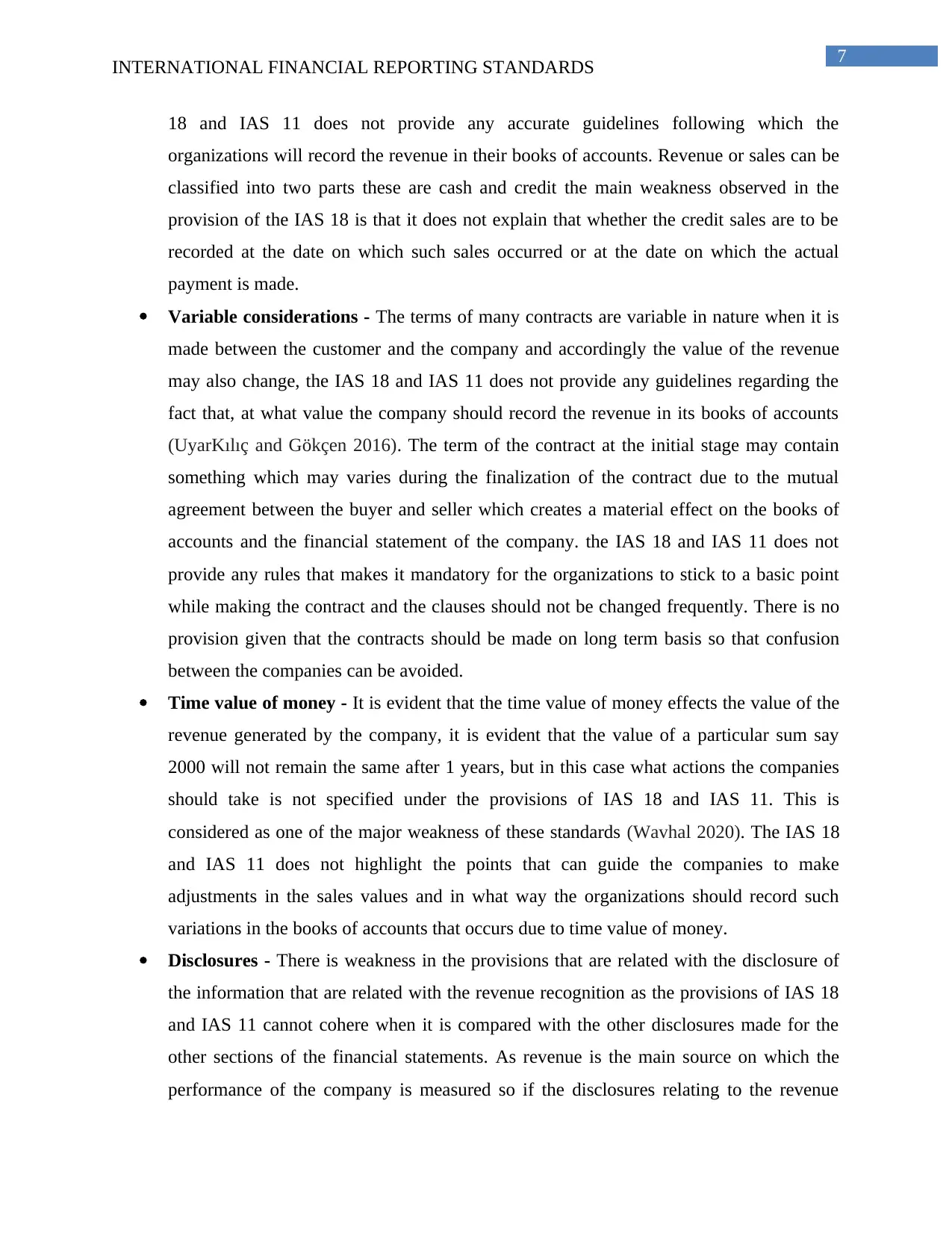
7
INTERNATIONAL FINANCIAL REPORTING STANDARDS
18 and IAS 11 does not provide any accurate guidelines following which the
organizations will record the revenue in their books of accounts. Revenue or sales can be
classified into two parts these are cash and credit the main weakness observed in the
provision of the IAS 18 is that it does not explain that whether the credit sales are to be
recorded at the date on which such sales occurred or at the date on which the actual
payment is made.
Variable considerations - The terms of many contracts are variable in nature when it is
made between the customer and the company and accordingly the value of the revenue
may also change, the IAS 18 and IAS 11 does not provide any guidelines regarding the
fact that, at what value the company should record the revenue in its books of accounts
(UyarKılıç and Gökçen 2016). The term of the contract at the initial stage may contain
something which may varies during the finalization of the contract due to the mutual
agreement between the buyer and seller which creates a material effect on the books of
accounts and the financial statement of the company. the IAS 18 and IAS 11 does not
provide any rules that makes it mandatory for the organizations to stick to a basic point
while making the contract and the clauses should not be changed frequently. There is no
provision given that the contracts should be made on long term basis so that confusion
between the companies can be avoided.
Time value of money - It is evident that the time value of money effects the value of the
revenue generated by the company, it is evident that the value of a particular sum say
2000 will not remain the same after 1 years, but in this case what actions the companies
should take is not specified under the provisions of IAS 18 and IAS 11. This is
considered as one of the major weakness of these standards (Wavhal 2020). The IAS 18
and IAS 11 does not highlight the points that can guide the companies to make
adjustments in the sales values and in what way the organizations should record such
variations in the books of accounts that occurs due to time value of money.
Disclosures - There is weakness in the provisions that are related with the disclosure of
the information that are related with the revenue recognition as the provisions of IAS 18
and IAS 11 cannot cohere when it is compared with the other disclosures made for the
other sections of the financial statements. As revenue is the main source on which the
performance of the company is measured so if the disclosures relating to the revenue
INTERNATIONAL FINANCIAL REPORTING STANDARDS
18 and IAS 11 does not provide any accurate guidelines following which the
organizations will record the revenue in their books of accounts. Revenue or sales can be
classified into two parts these are cash and credit the main weakness observed in the
provision of the IAS 18 is that it does not explain that whether the credit sales are to be
recorded at the date on which such sales occurred or at the date on which the actual
payment is made.
Variable considerations - The terms of many contracts are variable in nature when it is
made between the customer and the company and accordingly the value of the revenue
may also change, the IAS 18 and IAS 11 does not provide any guidelines regarding the
fact that, at what value the company should record the revenue in its books of accounts
(UyarKılıç and Gökçen 2016). The term of the contract at the initial stage may contain
something which may varies during the finalization of the contract due to the mutual
agreement between the buyer and seller which creates a material effect on the books of
accounts and the financial statement of the company. the IAS 18 and IAS 11 does not
provide any rules that makes it mandatory for the organizations to stick to a basic point
while making the contract and the clauses should not be changed frequently. There is no
provision given that the contracts should be made on long term basis so that confusion
between the companies can be avoided.
Time value of money - It is evident that the time value of money effects the value of the
revenue generated by the company, it is evident that the value of a particular sum say
2000 will not remain the same after 1 years, but in this case what actions the companies
should take is not specified under the provisions of IAS 18 and IAS 11. This is
considered as one of the major weakness of these standards (Wavhal 2020). The IAS 18
and IAS 11 does not highlight the points that can guide the companies to make
adjustments in the sales values and in what way the organizations should record such
variations in the books of accounts that occurs due to time value of money.
Disclosures - There is weakness in the provisions that are related with the disclosure of
the information that are related with the revenue recognition as the provisions of IAS 18
and IAS 11 cannot cohere when it is compared with the other disclosures made for the
other sections of the financial statements. As revenue is the main source on which the
performance of the company is measured so if the disclosures relating to the revenue
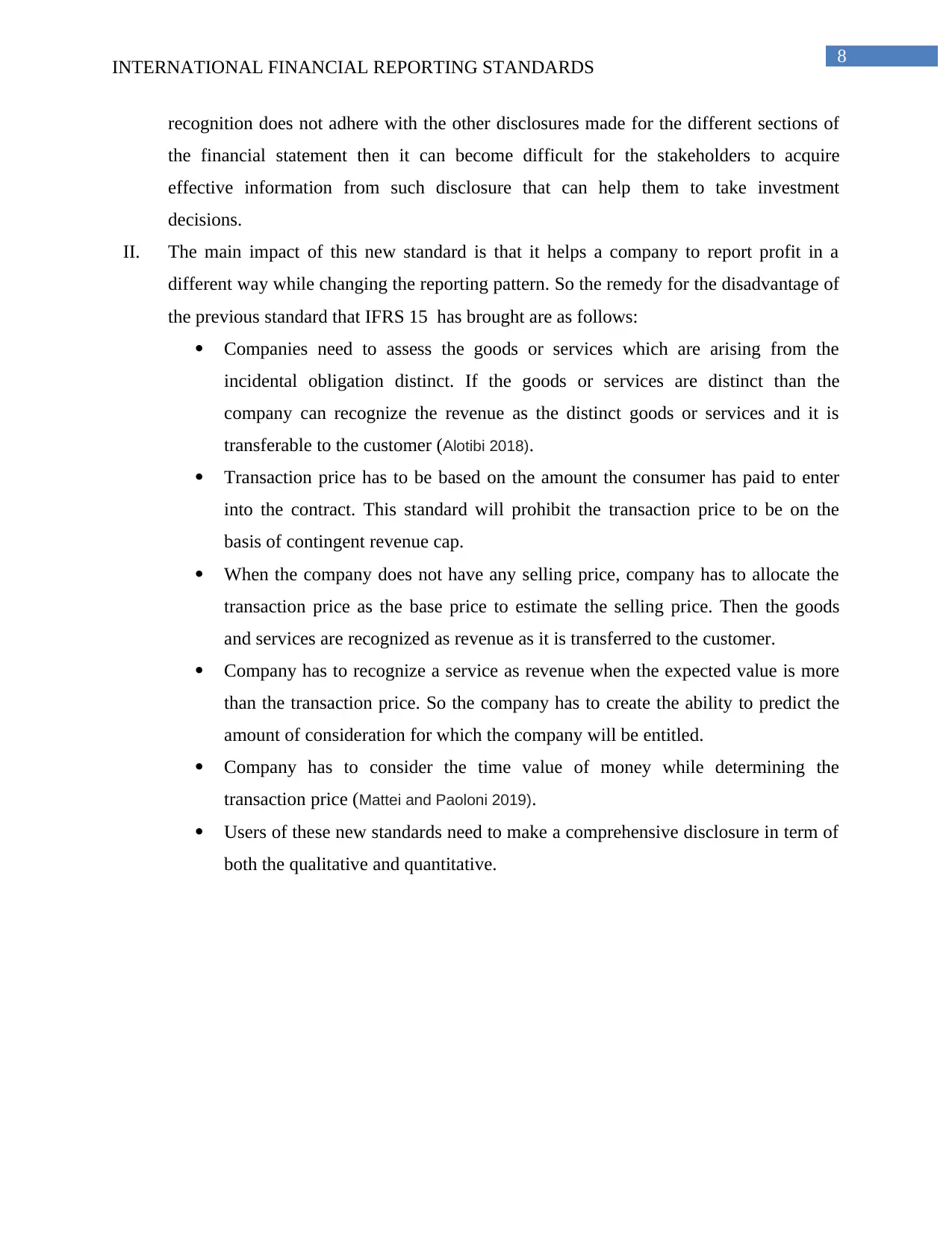
8
INTERNATIONAL FINANCIAL REPORTING STANDARDS
recognition does not adhere with the other disclosures made for the different sections of
the financial statement then it can become difficult for the stakeholders to acquire
effective information from such disclosure that can help them to take investment
decisions.
II. The main impact of this new standard is that it helps a company to report profit in a
different way while changing the reporting pattern. So the remedy for the disadvantage of
the previous standard that IFRS 15 has brought are as follows:
Companies need to assess the goods or services which are arising from the
incidental obligation distinct. If the goods or services are distinct than the
company can recognize the revenue as the distinct goods or services and it is
transferable to the customer (Alotibi 2018).
Transaction price has to be based on the amount the consumer has paid to enter
into the contract. This standard will prohibit the transaction price to be on the
basis of contingent revenue cap.
When the company does not have any selling price, company has to allocate the
transaction price as the base price to estimate the selling price. Then the goods
and services are recognized as revenue as it is transferred to the customer.
Company has to recognize a service as revenue when the expected value is more
than the transaction price. So the company has to create the ability to predict the
amount of consideration for which the company will be entitled.
Company has to consider the time value of money while determining the
transaction price (Mattei and Paoloni 2019).
Users of these new standards need to make a comprehensive disclosure in term of
both the qualitative and quantitative.
INTERNATIONAL FINANCIAL REPORTING STANDARDS
recognition does not adhere with the other disclosures made for the different sections of
the financial statement then it can become difficult for the stakeholders to acquire
effective information from such disclosure that can help them to take investment
decisions.
II. The main impact of this new standard is that it helps a company to report profit in a
different way while changing the reporting pattern. So the remedy for the disadvantage of
the previous standard that IFRS 15 has brought are as follows:
Companies need to assess the goods or services which are arising from the
incidental obligation distinct. If the goods or services are distinct than the
company can recognize the revenue as the distinct goods or services and it is
transferable to the customer (Alotibi 2018).
Transaction price has to be based on the amount the consumer has paid to enter
into the contract. This standard will prohibit the transaction price to be on the
basis of contingent revenue cap.
When the company does not have any selling price, company has to allocate the
transaction price as the base price to estimate the selling price. Then the goods
and services are recognized as revenue as it is transferred to the customer.
Company has to recognize a service as revenue when the expected value is more
than the transaction price. So the company has to create the ability to predict the
amount of consideration for which the company will be entitled.
Company has to consider the time value of money while determining the
transaction price (Mattei and Paoloni 2019).
Users of these new standards need to make a comprehensive disclosure in term of
both the qualitative and quantitative.
⊘ This is a preview!⊘
Do you want full access?
Subscribe today to unlock all pages.

Trusted by 1+ million students worldwide
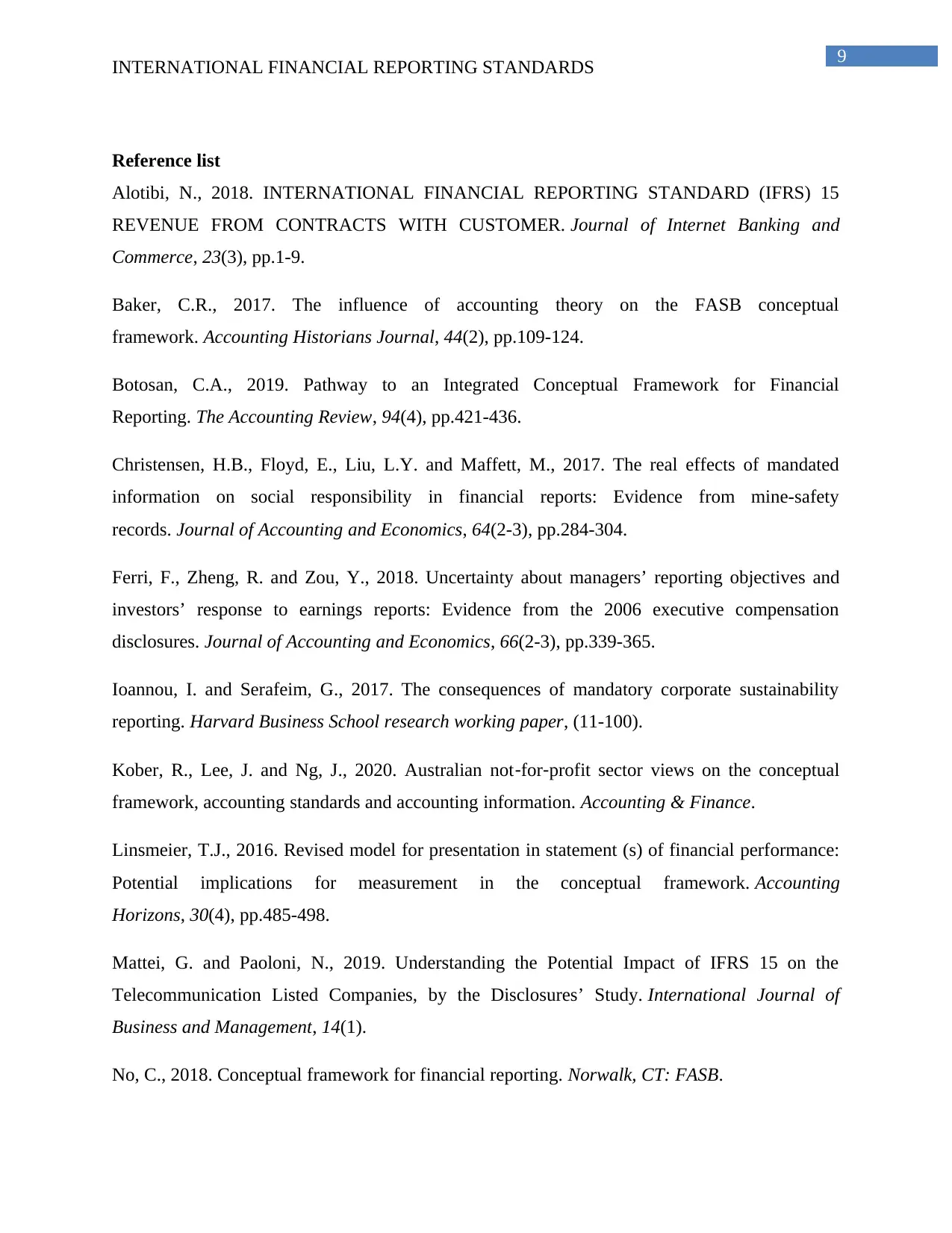
9
INTERNATIONAL FINANCIAL REPORTING STANDARDS
Reference list
Alotibi, N., 2018. INTERNATIONAL FINANCIAL REPORTING STANDARD (IFRS) 15
REVENUE FROM CONTRACTS WITH CUSTOMER. Journal of Internet Banking and
Commerce, 23(3), pp.1-9.
Baker, C.R., 2017. The influence of accounting theory on the FASB conceptual
framework. Accounting Historians Journal, 44(2), pp.109-124.
Botosan, C.A., 2019. Pathway to an Integrated Conceptual Framework for Financial
Reporting. The Accounting Review, 94(4), pp.421-436.
Christensen, H.B., Floyd, E., Liu, L.Y. and Maffett, M., 2017. The real effects of mandated
information on social responsibility in financial reports: Evidence from mine-safety
records. Journal of Accounting and Economics, 64(2-3), pp.284-304.
Ferri, F., Zheng, R. and Zou, Y., 2018. Uncertainty about managers’ reporting objectives and
investors’ response to earnings reports: Evidence from the 2006 executive compensation
disclosures. Journal of Accounting and Economics, 66(2-3), pp.339-365.
Ioannou, I. and Serafeim, G., 2017. The consequences of mandatory corporate sustainability
reporting. Harvard Business School research working paper, (11-100).
Kober, R., Lee, J. and Ng, J., 2020. Australian not‐for‐profit sector views on the conceptual
framework, accounting standards and accounting information. Accounting & Finance.
Linsmeier, T.J., 2016. Revised model for presentation in statement (s) of financial performance:
Potential implications for measurement in the conceptual framework. Accounting
Horizons, 30(4), pp.485-498.
Mattei, G. and Paoloni, N., 2019. Understanding the Potential Impact of IFRS 15 on the
Telecommunication Listed Companies, by the Disclosures’ Study. International Journal of
Business and Management, 14(1).
No, C., 2018. Conceptual framework for financial reporting. Norwalk, CT: FASB.
INTERNATIONAL FINANCIAL REPORTING STANDARDS
Reference list
Alotibi, N., 2018. INTERNATIONAL FINANCIAL REPORTING STANDARD (IFRS) 15
REVENUE FROM CONTRACTS WITH CUSTOMER. Journal of Internet Banking and
Commerce, 23(3), pp.1-9.
Baker, C.R., 2017. The influence of accounting theory on the FASB conceptual
framework. Accounting Historians Journal, 44(2), pp.109-124.
Botosan, C.A., 2019. Pathway to an Integrated Conceptual Framework for Financial
Reporting. The Accounting Review, 94(4), pp.421-436.
Christensen, H.B., Floyd, E., Liu, L.Y. and Maffett, M., 2017. The real effects of mandated
information on social responsibility in financial reports: Evidence from mine-safety
records. Journal of Accounting and Economics, 64(2-3), pp.284-304.
Ferri, F., Zheng, R. and Zou, Y., 2018. Uncertainty about managers’ reporting objectives and
investors’ response to earnings reports: Evidence from the 2006 executive compensation
disclosures. Journal of Accounting and Economics, 66(2-3), pp.339-365.
Ioannou, I. and Serafeim, G., 2017. The consequences of mandatory corporate sustainability
reporting. Harvard Business School research working paper, (11-100).
Kober, R., Lee, J. and Ng, J., 2020. Australian not‐for‐profit sector views on the conceptual
framework, accounting standards and accounting information. Accounting & Finance.
Linsmeier, T.J., 2016. Revised model for presentation in statement (s) of financial performance:
Potential implications for measurement in the conceptual framework. Accounting
Horizons, 30(4), pp.485-498.
Mattei, G. and Paoloni, N., 2019. Understanding the Potential Impact of IFRS 15 on the
Telecommunication Listed Companies, by the Disclosures’ Study. International Journal of
Business and Management, 14(1).
No, C., 2018. Conceptual framework for financial reporting. Norwalk, CT: FASB.
Paraphrase This Document
Need a fresh take? Get an instant paraphrase of this document with our AI Paraphraser
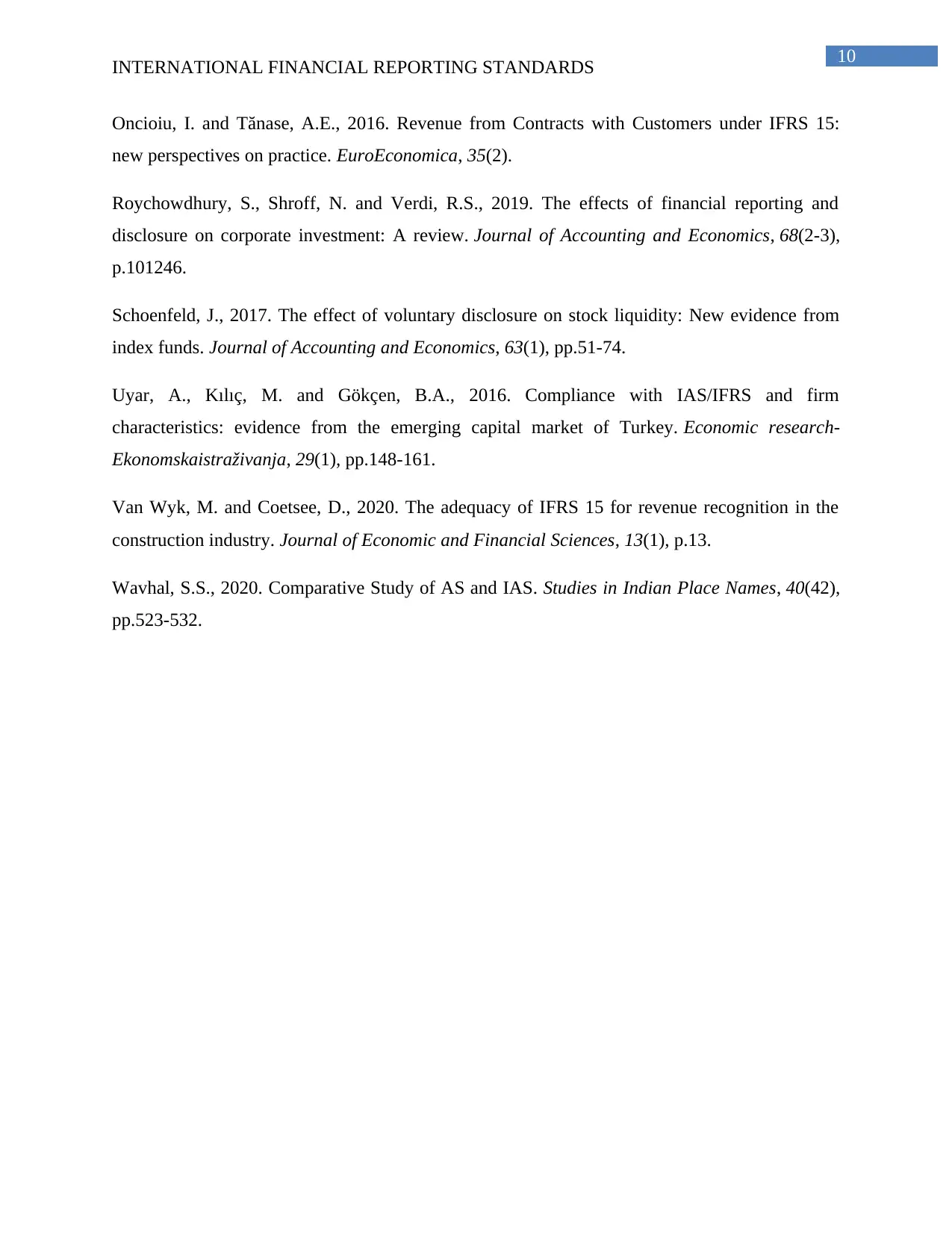
10
INTERNATIONAL FINANCIAL REPORTING STANDARDS
Oncioiu, I. and Tănase, A.E., 2016. Revenue from Contracts with Customers under IFRS 15:
new perspectives on practice. EuroEconomica, 35(2).
Roychowdhury, S., Shroff, N. and Verdi, R.S., 2019. The effects of financial reporting and
disclosure on corporate investment: A review. Journal of Accounting and Economics, 68(2-3),
p.101246.
Schoenfeld, J., 2017. The effect of voluntary disclosure on stock liquidity: New evidence from
index funds. Journal of Accounting and Economics, 63(1), pp.51-74.
Uyar, A., Kılıç, M. and Gökçen, B.A., 2016. Compliance with IAS/IFRS and firm
characteristics: evidence from the emerging capital market of Turkey. Economic research-
Ekonomskaistraživanja, 29(1), pp.148-161.
Van Wyk, M. and Coetsee, D., 2020. The adequacy of IFRS 15 for revenue recognition in the
construction industry. Journal of Economic and Financial Sciences, 13(1), p.13.
Wavhal, S.S., 2020. Comparative Study of AS and IAS. Studies in Indian Place Names, 40(42),
pp.523-532.
INTERNATIONAL FINANCIAL REPORTING STANDARDS
Oncioiu, I. and Tănase, A.E., 2016. Revenue from Contracts with Customers under IFRS 15:
new perspectives on practice. EuroEconomica, 35(2).
Roychowdhury, S., Shroff, N. and Verdi, R.S., 2019. The effects of financial reporting and
disclosure on corporate investment: A review. Journal of Accounting and Economics, 68(2-3),
p.101246.
Schoenfeld, J., 2017. The effect of voluntary disclosure on stock liquidity: New evidence from
index funds. Journal of Accounting and Economics, 63(1), pp.51-74.
Uyar, A., Kılıç, M. and Gökçen, B.A., 2016. Compliance with IAS/IFRS and firm
characteristics: evidence from the emerging capital market of Turkey. Economic research-
Ekonomskaistraživanja, 29(1), pp.148-161.
Van Wyk, M. and Coetsee, D., 2020. The adequacy of IFRS 15 for revenue recognition in the
construction industry. Journal of Economic and Financial Sciences, 13(1), p.13.
Wavhal, S.S., 2020. Comparative Study of AS and IAS. Studies in Indian Place Names, 40(42),
pp.523-532.
1 out of 11
Related Documents
Your All-in-One AI-Powered Toolkit for Academic Success.
+13062052269
info@desklib.com
Available 24*7 on WhatsApp / Email
![[object Object]](/_next/static/media/star-bottom.7253800d.svg)
Unlock your academic potential
Copyright © 2020–2025 A2Z Services. All Rights Reserved. Developed and managed by ZUCOL.



